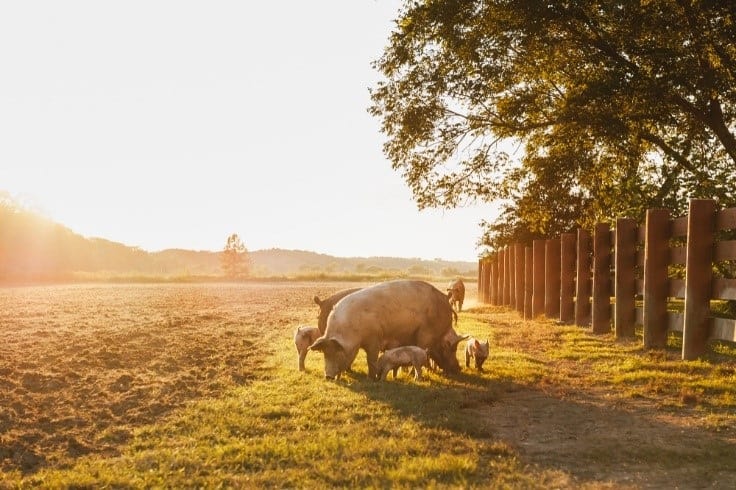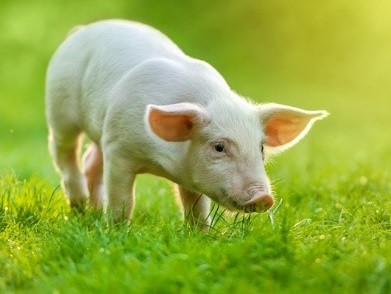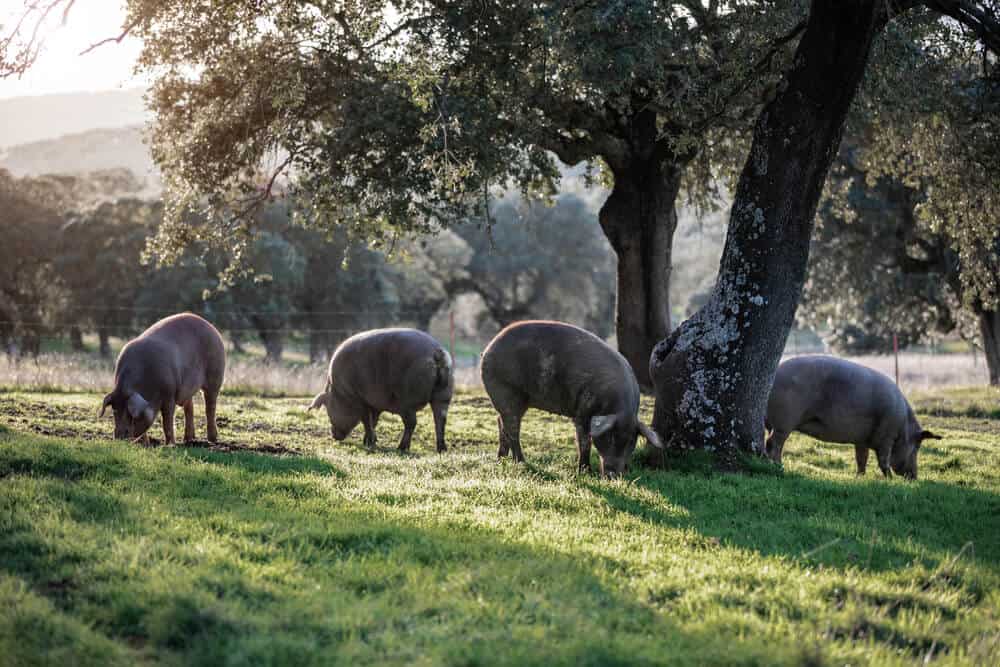One of the newest arrivals in the hog family, the Idaho Pasture pig, is a favorite among small-scale farmers for several good reasons. Commonly referred to as the IPP, “Pasture Pork,” “Grazing Pig,” and “Natural Pork,” Idaho Pasture pigs have quickly become a popular pig breed within the homesteading community.
Let’s take a quick look at the Idaho Pasture pig and why you might consider adding it to your farm.
What Is the Idaho Pasture Pig?
This new pig breed, IPP, was developed and introduced to the world by Gary and Shelly Farris from Idaho. Shelly Farris, who comes from Rigby, Idaho, saw the need for a pig that was good-natured and would also graze on the grass as opposed to rooting them.
The IPP comprises the Duroc, Kunekune pigs, and Berkshire pig breeds.
The Idaho Pasture pig was developed in 2006, but the breeding stock was introduced to the market in 2012. A great deal of work went into creating a breed of pig that is not only gentle-natured but small enough to work well on small family farms.
Idaho Pasture Pigs Facts
There are several reasons the Idaho Pasture pig has been received so warmly by the homesteading community. Here are some simple facts about this pig that will shed light on why it’s so popular.
Feeding Habits
The Idaho Pasture Pig was developed with one primary goal—becoming a “true” grazing pig. This meant that the pig needed to have an upturned snout, which allowed it to eat grass instead of rooting it. Most other pigs have a long straight snout, making it difficult to get to the grass.
While the Idaho Pasture Pig is primarily grass-fed, all pigs need lysine, which can only be found in grains. Because of that, the IPP can’t be 100% grass-fed. However, only 10 – 20% of the pig’s diet needs to be made up of the minerals and grains that their bodies require.

When feeding IPP minerals and grains, you need to mix them properly into the feed. This particular pig has a high level of toxicity to salt, which means that it can’t exactly be fed on mineral blocks or free-choice minerals. It’s easy to know when your IPP is lacking the necessary minerals. It will start digging into the ground to get the minerals it needs.
While feeding these pigs might sound simple and straightforward, some nutritional concerns come into play. Since these pigs feed primarily on grass, the kind of nutrients found in your soil directly affects their overall health because it determines how many nutrients are in the grass that they eat.
Think of it this way: If the soil on your farm doesn’t have enough selenium, then the grass that grows in that soil and that the pigs eat won’t have enough selenium either. This means you would have to supplement that somehow. You would have to test your soil to determine the amount of natural nutrients needed to figure out how much supplementing you would have to do.
Meat
Idaho Pasture pig meat is considered to be delicious. Since this pig feeds primarily on grass, its meat has a deeper red color, is well-marbled, and is laced with battery fat. This grass diet also gives the pork a much sweeter flavor than you would get with most other types of pigs.
Body Size and Shape
IPPs are designed to be smaller than many other pig breeds. One of the best reasons they are so popular is because they can be market-ready in about 8 – 10 months. Within that time, these excellent grazers can weigh up to 250 – 300 lbs. The sows reach maturity at around 250 – 350 lbs. The boars reach maturity at around 350 – 450 lbs.
These pigs also have a well-developed shoulder area, which leads to a long and level back. Its hams are often proportional to the rest of its body. When older boars are around two years old, they develop a shield that runs along their shoulder region.
Although these pigs are smaller than most other pig breeds, their size makes them ideal for families looking to raise pigs alongside other animals in a relatively small space.
Idaho Pasture Pig Mothering Capabilities
IPP sows have great maternal instincts. On average, a first-time mother can produce a litter with seven piglets. That number typically increases to around 8 – 10 piglets as the sow matures.
Contrary to common belief or desire, these smaller litter sizes are actually a bit of an advantage when it comes to IPPs. The sows aren’t as depleted as they normally would be with larger litter sizes.
Another interesting fact is that these sows don’t demand as much attention and care as typical ones when pregnant. Idaho Pasture pig sows don’t need creep feeders or farrowing crates.

That is not to say that you can’t have them. There are quite a number of different ways to set up your pigs outdoors. The kind of set-up you have will depend on your specific goals, the pasture area, the property layout, and the number of pigs being raised at a time.
These factors will play a key role in the kind of farrowing method you use. However, most farrowing methods will work just fine for Idaho Pasture pigs.
Unlike most other pig breeds, IPP sows have a gentler and friendlier nature. This means that you can actually get close to and take care of them better when they are farrowing and even when the litter comes into play.
Living Quarters
It should be noted that Idaho Pasture pigs, being primarily grazers, thrive outside. These pigs can be raised outdoors all year round, provided it doesn’t get too cold during the winter. This way, the pigs can enjoy the lush pastures and have enough room to graze, exercise, and socialize. Why do pigs like mud
Hardiness
The best part is that these pigs thrive in warm and cold weather. Like most, if not all, pigs, the IPP needs wallows to help regulate its temperature. This is especially true when it gets very hot outside.
These pigs do need shelter to keep them safe from predators and the elements. You can construct a wooded area that acts as a shade and a sleeping area for the pigs. Building a Barn or Shed for Animals
Raising Idaho Pasture Pigs
Finally, one of the most iconic features of this pig is that there’s hardly any smell associated with it. This is mostly because they spend so much time grazing (literally “grass fed”, in the wide open fields. What do pigs eat
Idaho Pasture pig meat is considered to be delicious. Since this pig feeds primarily on grass, its meat has a deeper red color, is well-marbled, and is laced with battery fat. This grass diet also gives the pork a much sweeter flavor than you would get with most other pig breeds.
Learn more about raising pigs for meat. Check out the Hampshire pig breed.

